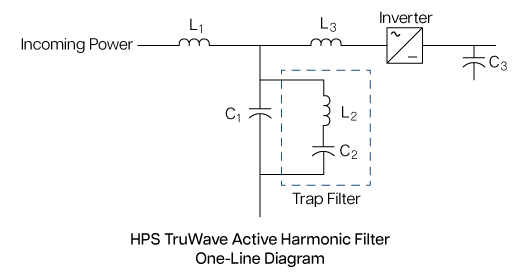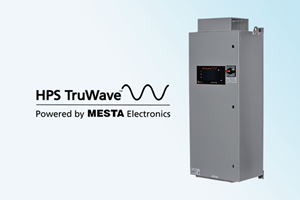High Frequency Harmonics Produced by Active Harmonic Filters
The HPS TruWave active harmonic filter (AHF) IGBT switching frequency is 10kHz which is typical for most AHFs on the market that use 2-level inverters. The 10kHz switching frequency is necessary in order mitigate harmonic currents from non-linear loads up to about the 50th harmonic which is 3kHz for the 60Hz power system (2.5kHz for a 50Hz system). This results in high frequency harmonic currents at 10kHz and integer multiples 10kHz (20kHz, 30kHz, etc.) flowing back toward the power system.
A filter is required on the input of the AHF in order to limit the amount of high frequency harmonics that are produced. Most AHF manufacturers simply use a LCL (series inductor, parallel line-to-line capacitor, series inductor) filter on the input. The larger the capacitance (C1), the lower the high frequency harmonic currents flowing back to the power system will be. If the capacitance is too large this will result in poor performance of the AHF in the 300Hz to 3kHz range and a possible system resonance. In order to avoid degrading the performance and/or causing a resonance, HPS uses a trap filter across the capacitors. The trap filter consists of an inductor in series with a capacitor. This trap filter results in lowering the 10kHz (and higher frequency) harmonic current from the TruWave AHF by a factor of 5 in comparison to one of the leading competitive products without compromising AHF performance. See one-line diagram from the HPS TruWave Active Filter below.

The HPS TruWave typically produces switching frequency currents on the order of 0.5% of the AHF rating. This will not adversely affect the operation of upstream transformers and will not usually even be audible. High frequency harmonic currents produced by competitive AHFs using 2-level inverters and LCL filters (but no trap filter) can have ill effects on upstream transformers due to mechanical vibration, as well as a substantial amount of audible noise and light flickering.

